The national debt of the United States was around 28.91 trillion dollars in November 2021, up 1.46 trillion dollars from a year earlier when it was around 27.45 trillion dollars.
How in debt is the US 2020?
The total national debt due by the federal government of the United States to Treasury security holders is known as the US national debt. The national debt is the face value of all outstanding Treasury securities issued by the Treasury and other federal government agencies at any one moment. The terms “national deficit” and “national surplus” normally relate to the federal government’s annual budget balance, not the total amount of debt owed. In a deficit year, the national debt rises because the government must borrow money to cover the gap, whereas in a surplus year, the debt falls because more money is received than spent, allowing the government to reduce the debt by purchasing Treasury securities. Government debt rises as a result of government spending and falls as a result of tax or other revenue, both of which fluctuate throughout the fiscal year. The gross national debt is made up of two parts:
- “Public debt” refers to Treasury securities held by people, corporations, the Federal Reserve, and foreign, state, and local governments, as well as those held by the federal government.
- Non-marketable Treasury securities held in accounts of federal government programs, such as the Social Security Trust Fund, are referred to as “debt held by government accounts” or “intragovernmental debt.” Debt held by government accounts is the result of various government programs’ cumulative surpluses, including interest earnings, being invested in Treasury securities.
Historically, the federal government’s debt as a percentage of GDP has risen during wars and recessions, then fallen afterward. The debt-to-GDP ratio may fall as a consequence of a government surplus or as a result of GDP growth and inflation. For example, public debt as a percentage of GDP peaked just after WWII (113 percent of GDP in 1945), then declined steadily over the next 35 years. Aging demographics and rising healthcare expenditures have raised concerns about the federal government’s economic policies’ long-term viability in recent decades. The United States debt ceiling limits the total amount of money Treasury can borrow.
The public held $20.83 trillion in federal debt, while intragovernmental holdings were $5.88 trillion, for a total national debt of $26.70 trillion as of August 31, 2020. Debt held by the public was around 99.3% of GDP at the end of 2020, with foreigners owning approximately 37% of this public debt. The United States has the world’s greatest external debt, with a debt-to-GDP ratio of 43rd out of 207 countries and territories in 2017. Foreign countries held $7.04 trillion worth of US Treasury securities in June 2020, up from $6.63 trillion in June 2019. According to a 2018 assessment by the Congressional Budget Office (CBO), public debt would reach approximately 100% of GDP by 2028, possibly more if current policies are prolonged past their expiration dates.
The federal government spent trillions on virus help and economic relief during the COVID-19 pandemic. According to the CBO, the budget deficit in fiscal year 2020 will be $3.3 trillion, or 16 percent of GDP, which is more than quadruple the deficit in fiscal year 2019 and the highest as a percentage of GDP since 1945.
Who is the US in the most debt to?
Important Points to Remember
- Public debt, which includes Treasury securities, accounts for around three-quarters of the government’s debt.
- As of April 2020, Japan was the largest foreign holder of public US government debt, with $1.266 trillion in debt.
Who owes America?
Debt of the State Over $22 trillion of the national debt is held by the general populace. 1 A substantial amount of the public debt is held by foreign governments, with the remainder held by American banks and investors, the Federal Reserve, state and local governments, mutual funds, pension funds, insurance companies, and savings bonds.
How Much Does China owe the US?
Ownership of US Debt is Broken Down China owns around $1.1 trillion in US debt, which is somewhat more than Japan. Whether you’re an American retiree or a Chinese bank, you should consider investing in American debt.
What happens if United States defaults on debt?
The government will be unable to borrow extra funds to meet its obligations, including interest payments to bondholders, unless Congress suspends or raises the debt ceiling. That would very certainly result in a default.
Investors who own U.S. debt, such as pension funds and banks, may go bankrupt. Hundreds of millions of Americans and hundreds of businesses that rely on government assistance might be harmed. The value of the dollar may plummet, and the US economy would almost certainly slip back into recession.
And that’s only the beginning. The dollar’s unique status as the world’s primary “unit of account,” implying that it is widely used in global finance and trade, could be jeopardized. Americans would be unable to sustain their current standard of living without this position.
A US default would trigger a chain of events, including a sinking dollar and rising inflation, that, in my opinion, would lead to the dollar’s demise as a global unit of account.
All of this would make it far more difficult for the United States to afford all of the goods it buys from other countries, lowering Americans’ living standards.
How Much Is America worth?
As of Q1 2014, the United States’ financial position included assets worth at least $269.6 trillion (1576 percent of GDP) and debts worth at least $145.8 trillion (852 percent of GDP), resulting in a net worth of at least $123.8 trillion (723 percent of GDP).
The ratio of public to private debt in the United States climbed from 152 percent of GDP in 1980 to 296 percent GDP in 2008, before decreasing to 279 percent GDP in Q2 2011. Foreclosures and higher rates of household saving contributed to the drop from 2009 to 2011. Except for the government, which ran high deficits to counter deleveraging or debt reduction in other sectors, other sectors had considerable reductions in debt to GDP.
As of 2009, US consumers, businesses, and governments held $50.7 trillion in debt, which was more than 3.5 times the country’s yearly gross domestic output. Domestic financial assets were $131 trillion and domestic financial liabilities were $106 trillion in the first quarter of 2010. In 2008, tangible assets (such as real estate and equipment) reached an additional $56.3 trillion for chosen sectors.
Why does the US have so much debt?
The overall federal financial obligation owing to the public and intragovernmental departments is known as the US debt. The US national debt is so large because Congress continues to spend money on deficits while also cutting taxes.
Does any country owe the US money?
Many countries, including Japan, mainland China, the United Kingdom, Ireland, Luxembourg, Brazil, Switzerland, and Belgium, owe money to the United States.
How can the US pay off its debt?
The debt ceiling is a limit on how much money the government of the United States can borrow to pay its debts. Every year, Congress passes a budget that includes government expenditure on infrastructure, social security programs, and federal employee wages. To pay for all of this spending, Congress levies taxes on the general public.
Why does the US owe China money?
China’s appetite for Treasurys helps to keep interest rates in the United States low. It enables the US Treasury to borrow more money at low interest rates. The growth of China’s economy is aided by holding US Treasury notes. The demand for dollar-denominated bonds boosts the dollar’s value against the yuan.
What country has no debt?
Brunei is one of the least indebted countries in the world. It has a debt-to-GDP ratio of 2.46 percent, making it the world’s debt-free country with a population of 439,000 people. Brunei is a tiny island nation in Southeast Asia. Despite this, Brunei has been recognized as one of the richest countries in the world due to its oil and gas development. Since gaining independence from the United Kingdom in 1984, the country has experienced remarkable economic growth in the 1990s.





